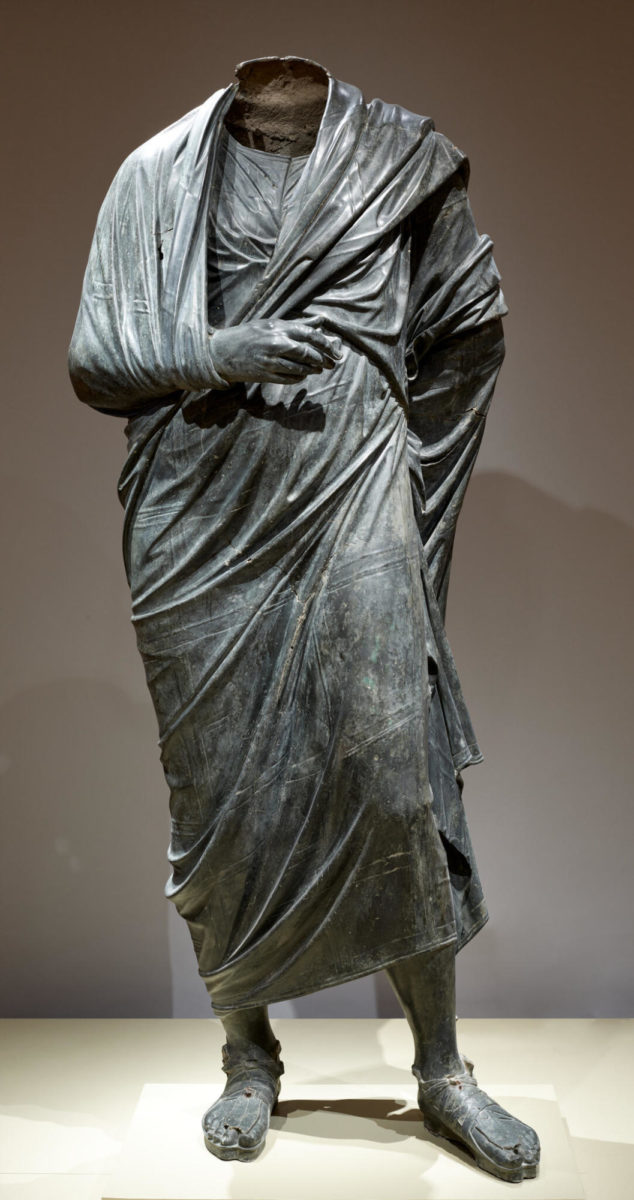A headless bronze statue thought to depict Roman emperor Marcus Aurelius was recently removed from the Cleveland Museum of Art (CMA) as part of an investigation by New York officials into looted antiquities from Turkey. Turkish officials allege that the 6-foot-4-inch statue, valued at $20 million, was stolen by smugglers from an archaeological site called Bubon in the 1960s.
The CMA acquired the statue in 1986, and for decades it had been a highlight in the museum’s Roman collection. The statue, which resembles a Greek philosopher, is believed to depict Marcus Aurelius, a second-century Roman emperor and Stoic philosopher who wrote the “Meditations.”
Maggie Popkin, associate professor of art history at Case Western Reserve University, said that it is difficult to identify the subject of the statue with certainty because the statue doesn’t have a head, nor does anyone have documentation as to where it was actually discovered. “When we do not know where a statue came out of the ground, surrounded by what other artifacts and features, we lose so much information about it,” Popkin explains. In other words, the statue’s association with Marcus Aurelius is an identification based on the best available circumstantial evidence since scholars have not found definitive proof.
The Turkish government first made a claim in 2012 that the statue and 20 other artifacts in the CMA were looted and illegally obtained. The CMA stated at the time that Turkey had no hard evidence that the antiquities were looted.
The Manhattan district attorney’s office said that the statue’s seizure is related to an “ongoing criminal investigation into a smuggling network involving antiquities looted from Turkey and trafficked through Manhattan,” according to a statement given in The New York Times. Since the accused traffickers of the Marcus Aurelius statue are based in New York, officials from that state had the legal jurisdiction to seize an artifact from Ohio.
Turkish officials were able to persuade investigators that the statue originated in Bubon in part because of an inscription on a statue base, which has been known since 1993, bearing the name of Marcus Aurelius.
Until recently, the CMA’s website called the statue “The Emperor as Philosopher, probably Marcus Aurelius (reigned AD 161-180),” and its origin was listed as “Turkey, Bubon(?) (in Lycia), Roman, late 2nd Century.” At some point in the last several weeks, the CMA removed all references to Turkey and Marcus Aurelius from its website. The statue is now called “Draped Male Figure, c. 150 BCE-200 CE” with a “Roman or possibly Greek Hellenistic” origin.
“The Cleveland Museum of Art takes provenance issues very seriously and reviews claims to objects in the collection carefully and responsibly,” the CMA said in a statement. “As a matter of policy, the CMA does not discuss publicly whether a claim has been made. The CMA believes that public discussion before a resolution is reached detracts from the free and open dialogue between the relevant parties that leads to the best result for all concerned.”
The CMA has not been the only museum affected by this probe. Over the last year while investigating Turkish looting, the Antiquities Trafficking Unit of the Manhattan district attorney’s office has seized Greco-Roman artifacts from other American museums, including the Metropolitan Museum of Art, the Worcester Art Museum and the Fordham Museum of Greek, Etruscan and Roman Art.
A similar story occurred in 2012 when the CMA acquired a portrait head of Drusus Minor, the son of the Roman emperor Tiberius. The bust was initially believed to have originated in North Africa, but a study of a companion head indicated that this head was illegally removed from Italy during World War II. “[I]t wasn’t just a study of a companion head that provided evidence of the statue’s origin in Italy. Rather, the actual head of Drusus that the CMA acquired had been published in the 1920s when it was first uncovered in Italy,” said Popkin. “It had in fact been found at the site of Sessa Aurunca in Italy; it was not from North Africa, as the dealer and CMA’s curator at the time suggested. Evidently the statue had been illegally removed from Italy at the end of World War II.” In 2017 the CMA publicly acknowledged that the bust was illegally obtained, and they returned it to Italy.
The future location of the Marcus Aurelius statue is currently unknown. The statue’s fate depends on whether the statue’s connection to Bubon can be proven.
The fact that the statue depicts a man in the style of a Greek philosopher makes identification difficult since most Roman emperors, including Marcus Aurelius, depicted themselves in heroic nudity, wearing military attire, donning the Roman toga or riding a horse. “If the statue were not Marcus Aurelius, we would not necessarily associate it with Bubon and, indeed, might identify it, without its head, as an honorific statue of a philosopher or man dressed as a philosopher from Greece or Asia Minor,” Popkin explained. “Conversely, if the statue were not from Bubon, we would probably not identify it as Marcus Aurelius, because Roman emperors were only very, very rarely depicted in the garb of Greek philosophers.” Further study of the statue and its supposed home of Bubon may help solidify or refute the link to the archeological site, but Popkin said, “These sorts of avenues of research would not necessarily result in evidence that would provide a definitive answer, but they might help us get closer to the answer.”



